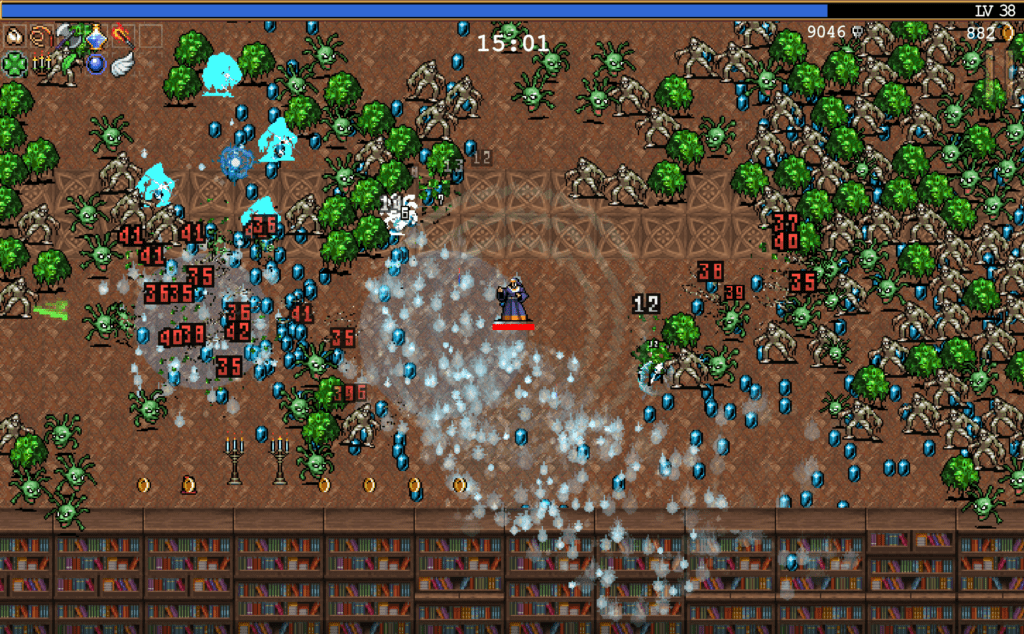For my critical play, I selected Vampire Survivors. While not a gambling game per se, its creator, Luca Galante, spent years programming slot machines prior to the game’s success, and those influences can be clearly seen in the game. Specifically, Vampire Survivors uses intense audiovisual stimuli and the near miss effect to keep players coming back again and again. While I couldn’t play with others due to the nature of the game, I instead watched a few videos of people playing the game, to get a sense of how people talked about the chance elements.
Intense Audiovisual Stimuli
The entire game is filled with animations and sounds designed to be as satisfying as possible. Enemies flash when they are damaged, and disintegrate when killed. Then, they have a chance to drop a gemstone. The player needs to pick up those gemstones to level up and unlock new abilities—and the game rewards them with a chime every time they pick one up. Walking into a pile of these from a group of decimated enemies triggers a chorus of chimes as your xp bar fills, reminiscent of a jackpoint of coins clattering out of an old slot machine. As the player survives longer, the screen will quickly become covered in colorful flashing lights—so severe the game comes with an epilepsy warning. It’s not unlike the stimulating atmosphere Vegas casinos attempt to create.

Nothing in the game is more reminiscent of Vegas, though, than the screen for opening a chest. Everything pauses as swirling lights dive in and out of the chest. The potential rewards cycle past you, just like a slot machine, as a gold counter ticks up below. Special music surges, and you’re left with bated breath as you see how long it will count up before it stops. Everything detail is designed to build anticipation and make getting a chest as exciting as possible. In one of the videos I reviewed, the player was told they could skip the animation (which is long), and responded “Why would I skip the animation? That’s the best part of this game!”

It’s unusual, to say the least, for a single animation sequence to be a player’s favorite part of a game, but considering Galante’s history, it makes perfect sense. In an interview with The Verge, he noted that in the slot machine industry, “[the player] is actually spending money every time they press it, and because of that, there’s a huge attention to detail on the sounds, the animations, and the sequences, because you have so few elements to work with.”
As with any game of chance, there is a tiny chance for huge rewards: chests have a small chance to contain three items, and an even slimmer chance to contain five (with correspondingly higher gold payouts). I only got these jackpots twice in a few hours of play, but the tantalizing possibility kept me hoping every time I recklessly dove into a horde of enemies to open one. I wasn’t the only one—one of the players I watched commented “I’m probably going to die, but I’m going in anyway.” To some extent, this risk-taking makes sense—chests are a big reward—but I think the elements of chance make players much more likely to take risks to get a chest than they rationally should.

The “Near Miss” Effect
In blackjack, a player who busts at 22 is much more likely to play again than a player who busts at 25, even though the outcome is the same in both cases. This is because near-misses trigger the same reward centers in our brains that actual wins do. When we experience a near miss, we anticipate what the reward could have been if things had gone slightly differently, and our brains don’t always distinguish well between anticipation and the real thing. As a result, near misses have been shown to increase the likelihood that a player gambles again.
Many rouge-like or rouge-lite games naturally incorporate the “near-miss” effect, and Vampire Survivors is no different. A few mistakes or a streak of bad luck can end a run at any time, and yet it is always easy to see how things could have gone differently—I could have dodged left instead of right, or that enemy horde could have spawned just a little differently. Moreover, because there’s always another chest or level-up right around the corner, the future of a run always feels like a landscape of limitless potential, if only you could survive a few more minutes. As such, almost every failed attempt feels like a near miss, creating an itch to jump back in and try one more time.
Risk of Addiction
Compared to a slot machine that costs and rewards actual money, Vampire Survivors is quite tame. Without real money at stake, there’s less potential for crazy dopamine highs and lows, or for a player trapped in a losing spiral to feel that they need to “win back” their losses. The stakes are lower, too—at worst, Vampire Survivors wastes your time (assuming you didn’t enjoy yourself, which given how compelling the gameplay is, seems unlikely).
Still, I think the techniques employed here, which do serve to make the game as fun as it is, also give the game the potential to get players stuck more than most games. I know I wound up playing longer than I meant to and stayed up too late as a result. People who struggle with self-regulation around games should probably go in knowing this one will target the reward centers of their brain with expert proficiency.



